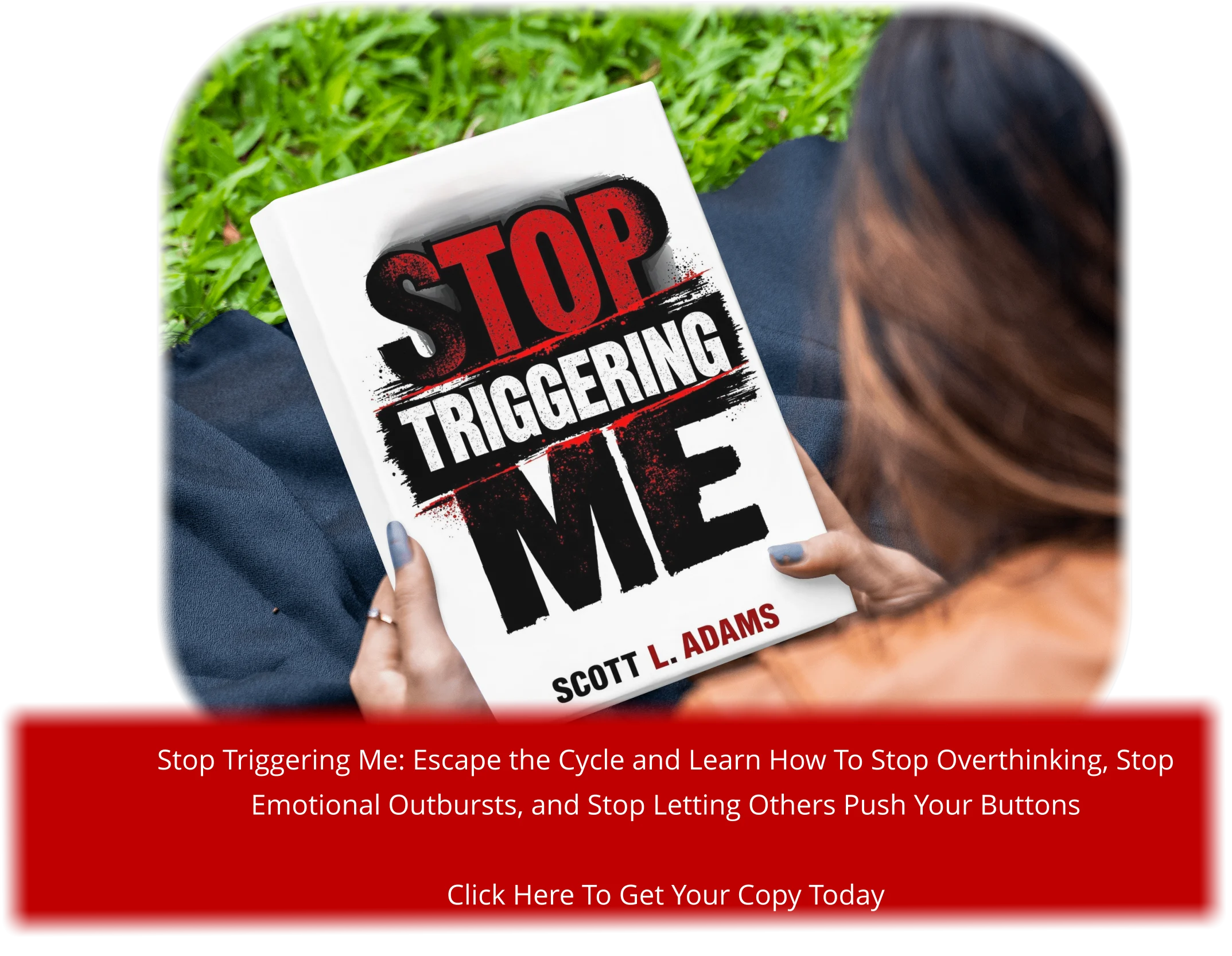Have you ever had someone in your life who just knows how to get under your skin? Maybe it’s a coworker who always interrupts you in meetings or a family member who never seems to respect your boundaries. These interactions can leave you feeling frustrated, drained, and even questioning your own reactions.
I’ve been there too. At work, I once had a colleague who constantly challenged my ideas in front of others. It felt personal, and I struggled to stay calm. Over time, I learned that understanding how to navigate these moments is less about the other person and more about how I respond. It’s about finding ways to stay grounded and focused, even when emotions run high.
Handling these situations effectively can transform your relationships and reduce stress. Whether it’s at home or in the workplace, mastering the art of resolution can lead to more constructive outcomes and healthier interactions1. Let’s explore practical strategies to help you stay calm and in control, even when someone is pushing your buttons.
Key Takeaways
- Understanding your triggers is the first step to staying calm.
- Effective resolution strategies can improve relationships.
- Staying grounded helps you respond, not react.
- Practical tips can reduce stress in challenging situations.
- Healthy interactions lead to better outcomes at work and home.
Identifying Your Triggers and Emotional Responses
Do you find yourself reacting strongly to certain behaviors? It’s not uncommon to feel this way. Often, our emotional responses are tied to deeper triggers—those moments when someone’s actions or words hit a nerve. Understanding these triggers is the first step toward staying calm and in control.
Recognizing Personal Values and Perceptions
Your values and perceptions play a big role in how you process challenging interactions. For example, if you value respect, being interrupted might feel like a personal attack. It’s important to identify what matters most to you. This awareness helps you understand why certain behaviors upset you and how to respond constructively.
Research shows that individuals who articulate their triggers can reduce emotional responses by 30%, enhancing their coping mechanisms2. Take a moment to reflect on what’s behind your reactions. Is it tied to a past experience or a core belief?
Spotting Power Dynamics and Biases
Power dynamics and biases can intensify emotional reactions. For instance, a coworker’s dismissive tone might feel more frustrating if you perceive them as having more authority. Recognizing these dynamics helps you separate the person from the situation.
Creating a safe space for dialogue about emotional triggers can lead to a 40% increase in relationship satisfaction2. Whether at work or home, being aware of these dynamics allows for healthier interactions. Ask yourself: Is this about the other person, or is it about how I’m interpreting their actions?
Here are some practical tips to help you identify and manage your triggers:
- Reflect on past experiences to understand recurring patterns.
- Practice mindfulness to stay present and grounded.
- Communicate openly about what bothers you in a calm and respectful way.
By tuning into your emotional responses, you can transform challenging interactions into opportunities for growth. It’s not about changing the other person—it’s about understanding yourself better.
Understanding Conflict Dynamics in Daily Interactions
Ever felt like certain interactions drain your energy more than others? Whether it’s a heated discussion with a coworker or a misunderstanding with a loved one, these moments can leave you feeling frustrated and exhausted. Understanding the dynamics behind these interactions is key to improving both your relationships and productivity.
Daily conflicts can have a ripple effect. At work, unresolved issues can lead to low morale and reduced output. In personal relationships, they can create distance and resentment. Recognizing these patterns is the first step toward finding a better way forward.
Impact on Relationships and Productivity
When conflicts go unaddressed, they can harm both personal and professional dynamics. For example, 70% of employees report experiencing conflict at work, which often leads to reduced productivity and increased stress3. At home, unresolved disagreements can strain relationships, making it harder to connect on a deeper level.
Here’s how you can address these challenges:
- Identify recurring patterns in your interactions to understand what triggers tension.
- Develop effective strategies to handle difficult situations calmly and constructively.
- Set clear goals for how you want to respond, focusing on mutual understanding rather than winning the argument.
Balancing emotional responses is crucial. When you stay calm, you’re better equipped to find solutions that work for everyone. Teams that use effective strategies see a 25% improvement in collaboration3. This skill not only improves relationships but also boosts overall productivity.
By recognizing the dynamics at play, you can transform challenging interactions into opportunities for growth. It’s not about avoiding conflict—it’s about handling it in a way that strengthens connections and fosters positive outcomes.
Exploring Different Conflict Resolution Styles
Have you ever wondered why some disagreements feel harder to resolve than others? The way we approach these moments can make all the difference. Experts like Thomas and Kilmann have identified five major styles to handle disputes effectively. Each style has its place, depending on the situation and the people involved.
Accommodating vs. Avoiding: When to Yield
Sometimes, yielding can be the best choice. The accommodating style focuses on meeting others’ needs, even if it means setting aside your own. This approach works well when maintaining harmony is more important than winning the argument. For example, an employee might accommodate a coworker’s request to keep the team united.
On the other hand, avoiding can provide temporary relief. However, it often leads to unresolved issues that escalate over time, affecting team dynamics and morale4. Knowing when to step back is key. If the issue isn’t critical, avoiding it might save energy for more important battles.
Collaborating vs. Competing: Finding Balance
Collaborating fosters a cooperative environment where everyone’s input is valued. This style aims for solutions that satisfy all parties, making it ideal for complex problems. For instance, a team might collaborate to develop a project plan that meets everyone’s needs.
In contrast, the competing style prioritizes one’s own needs over others. While it can be effective in emergencies, overuse may harm relationships5. Balancing these styles ensures both assertiveness and empathy are present.
Compromising: Negotiating Win-Win Solutions
Compromising involves making concessions to reach a quick resolution. It’s useful when time is limited, but it may leave both parties partially dissatisfied4. For example, two employees might compromise on a deadline to meet their team’s goals.
Choosing the right style depends on the situation. By understanding these approaches, you can tailor your response to achieve the best outcome for everyone involved.
Mastering Conflict Management Techniques
Have you ever felt stuck in a disagreement that seemed impossible to solve? It’s a common experience in life, but the way you approach it can make all the difference. Whether it’s a heated discussion at work or a misunderstanding at home, mastering the right techniques can help you find a solution and move forward.
Assessing the Situation Effectively
The first step to resolving any dispute is understanding it. Start by asking the right questions. What’s the root cause? How does each person feel about it? Gathering this information helps you see the bigger picture. Teams that take time to assess situations see a 30% improvement in collaboration6.
Next, analyze the dynamics. Are there power imbalances or personal biases at play? Recognizing these factors can help you tailor your approach. For example, in a workplace setting, understanding team roles can lead to more effective solutions7.
Implementing the Approach with Confidence
Once you’ve assessed the situation, it’s time to act. Choose an approach that fits the context. For instance, a collaborative style works well when everyone’s input is needed. This method has been shown to increase satisfaction levels by 80%6.
Confidence is key. Trust your ability to navigate the situation and stay focused on the solution. Remember, it’s not about winning but finding a resolution that works for everyone. Teams that implement structured strategies see a 40% reduction in disputes7.
Here are some practical tips to help you succeed:
- Stay calm and composed, even when emotions run high.
- Communicate clearly to ensure everyone understands the plan.
- Follow up to ensure the solution is working and make adjustments if needed.
By mastering these techniques, you can transform challenging moments into opportunities for growth. It’s about taking control of the situation and finding a way forward that benefits everyone involved.
Practical Communication Tips for Defusing Tension
Ever been in a conversation where the tension felt like it could snap at any moment? I’ve been there too. Whether it’s a heated discussion at work or a misunderstanding with a loved one, these moments can leave you feeling drained. The good news? With the right communication techniques, you can defuse tension and create a more positive outcome.
Active Listening Techniques
Active listening is more than just hearing words—it’s about understanding the other person’s perspective. When I started practicing this, I noticed a significant shift in how conversations unfolded. Reflective listening, where you repeat back what you’ve heard, can help clarify misunderstandings and show that you’re truly engaged8.
Another technique is summarizing the other person’s point. This not only ensures you’ve understood correctly but also invites them to clarify if needed. Research shows that active listening can improve resolution success rates by 60%9.
Clear Communication to Enhance Productivity
Clear communication is essential in reducing tension. When everyone understands the point being made, it’s easier to find common ground. I’ve found that using simple, direct language helps prevent misunderstandings that can lead to resentment.
For example, instead of saying, “You never listen,” try, “I feel unheard when my ideas aren’t acknowledged.” This approach shifts the focus from blame to understanding, fostering a more productive conversation10.
Inviting Compromise and Reducing Resentment
Compromise is key to resolving tension. It’s not about winning but finding a solution that works for everyone. I’ve learned that offering alternatives during discussions can increase the chances of reaching a mutual agreement by 30%9.
Here are some practical tips to invite compromise:
- Stay calm and composed, even when emotions run high.
- Communicate clearly to ensure everyone understands the point.
- Be open to alternatives and willing to adjust your stance.
By mastering these techniques, you can transform tense conversations into opportunities for growth. It’s about creating a space where everyone feels heard and valued, reducing resentment and fostering healthier interactions.
Applying Strategies in the Workplace and Beyond
Have you ever faced a situation at work where tension seemed unavoidable? I’ve been there too. Whether it’s a misunderstanding with a colleague or a project that’s falling behind, these moments can feel overwhelming. But with the right strategies, you can turn these challenges into opportunities for growth.
Unresolved disputes can harm both relationships and productivity. For example, miscommunication is a common cause of workplace issues, often leading to misunderstandings and resentment11. Addressing these problems promptly is key to maintaining a positive work environment.
Managing Workplace Disputes Effectively
One of the best ways to handle workplace issues is through open communication. Teams that foster clear dialogue experience a 30% reduction in disputes12. When everyone feels heard, it’s easier to find common ground and move forward.
Another effective strategy is active listening. This technique not only helps clarify misunderstandings but also builds trust. Research shows that active listening can improve resolution success rates by 50%12. It’s a simple yet powerful tool for defusing tension.
Here are some best practices for managing workplace disputes:
- Address issues promptly to prevent them from escalating.
- Use “I” statements to express your feelings without blaming others.
- Seek professional development through courses or workshops to enhance your skills.
Investing time in learning these techniques can make a big difference. Organizations that provide conflict resolution training see a 70% reduction in workplace disputes12. It’s a win-win for everyone involved.
By applying these strategies, you can improve relationships and resolve issues efficiently. It’s about creating a workplace where everyone feels valued and heard. Remember, the goal isn’t to avoid disputes but to handle them in a way that strengthens connections and fosters positive outcomes.
Cultivating Empathy and Setting Boundaries
Have you ever noticed how empathy can transform a tense situation into a moment of connection? I’ve seen it happen in my own life, whether at work or at home. When we take the time to understand others’ perspectives, it creates a foundation for mutual respect and healthier interactions. But empathy alone isn’t enough—setting clear boundaries is equally important. Together, these two practices can prevent recurring issues and foster a more positive environment.
Establishing Clear Personal Boundaries
Boundaries are essential for personal well-being and effective communication. I learned this the hard way when I realized that saying “yes” to everything left me feeling drained and resentful. Clear boundaries help you protect your energy and focus on what truly matters. For example, in a workplace setting, setting limits on your availability can prevent burnout and improve productivity13.
Here are some actionable steps to establish boundaries:
- Communicate your needs clearly and respectfully.
- Practice self-awareness to recognize when your limits are being tested.
- Be consistent in enforcing your boundaries to build trust.
Research shows that individuals who set clear boundaries experience a 40% reduction in stress and improved relationships14. It’s not about being rigid—it’s about creating a space where everyone feels respected.
Fostering Mutual Respect
Mutual respect is the cornerstone of any healthy relationship, whether in a group or an organization. I’ve seen how empathy can bridge gaps and resolve misunderstandings. For instance, when team members actively listen to each other, it fosters trust and collaboration13.
One powerful way to cultivate respect is through open communication. Encouraging dialogue allows everyone to share their thoughts and feelings, reducing the likelihood of recurring problems. Studies show that teams that prioritize empathy see a 30% increase in innovation and creativity14.
Here’s how you can foster mutual respect:
- Practice active listening to understand others’ perspectives.
- Acknowledge feelings to defuse tension and build connection.
- Encourage collaboration to find solutions that work for everyone.
By combining empathy with clear boundaries, you can create a more harmonious environment. It’s about understanding others while also respecting your own needs. This balance is key to preventing workplace conflict and building stronger relationships.
Strategies for Long-Term Conflict Resolution
What if you could turn every challenging interaction into an opportunity for growth? I’ve learned that resolving disputes isn’t just about fixing the immediate issue—it’s about building skills that last. Over time, I’ve discovered that sustainable strategies can transform how you approach conflict, leading to healthier relationships and better outcomes.
Building Sustainable Skills
Developing long-term skills starts with understanding both sides of the equation. It’s not just about your perspective but also about the other person’s needs and feelings. Research shows that emotional awareness can improve resolution outcomes by 50%15. When you balance your approach with empathy, you create a foundation for lasting solutions.
One of the most effective ways to build these skills is through collaboration. Teams that prioritize collaboration see a 25% reduction in disputes16. By working together, you can find solutions that satisfy everyone involved.
Gathering Information and Learning
Continually gathering information is key to improving your approach. I’ve found that understanding the root cause of a dispute often leads to better resolutions. For example, 85% of workplace issues stem from poor communication16. By addressing this, you can prevent recurring problems.
Here are some practical tips to enhance your skills:
- Ask questions to understand the other side’s perspective.
- Reflect on past experiences to identify patterns and learn from them.
- Stay open to feedback to continually improve your approach.
Balancing Perspectives for Better Outcomes
Balancing your perspective with the other side’s is crucial. It’s not about winning but finding a solution that works for everyone. Studies show that collaborative negotiation styles are the most effective for fostering long-term relationships17.
By focusing on mutual respect and understanding, you can elevate your skills and create a more harmonious environment. It’s about building trust and fostering growth, one interaction at a time.
Conclusion
Navigating challenging interactions can feel overwhelming, but it’s also an opportunity to grow. Throughout this guide, we’ve explored practical strategies to stay calm, understand triggers, and foster healthier relationships. Whether it’s at work or home, these techniques can transform how you respond in every instance.
Reflect on your personal experiences and consider how these approaches might apply. For example, active listening and clear communication can reduce tension and improve collaboration18. Staying open to learning, whether online or through courses, can enhance your ability to handle difficult situations with confidence.
Remember, it’s not about avoiding disagreements but addressing them constructively. By balancing empathy with clear boundaries, you can create a space where everyone feels heard and respected. Take these insights and use them to build stronger connections and improve your overall well-being.







